Development of Vibration Control Structure on Suspended Ceiling Using Pulley Mechanism
Abstract
:1. Introduction
2. Pulley–Damper Ceiling System
2.1. Mechanism of the System
2.2. Derivation of the Constitutive Equation
- Step 1: Calculate the damper displacement using truss force and displacement from Equation (9);
- Step 2: Determine the damper force ;
- Step 3: Update the truss axial forces using Equation (8).
3. Component Details of the Pulley–Damper System
3.1. Friction Test of the Pulley Sheaves
3.2. Dynamic Test of the Viscous Damper
4. Full-Scale Shake Table Test
4.1. Shake Table and Test Specimens
4.2. Test Cases for the Shaking Table Tests
4.3. Measurement Plan and Input Excitations
4.4. Full-Scale Shake Table Test Results
5. Simulation Analysis
5.1. Simulation Model
5.2. Simulation Results
6. Conclusions
- The fundamental concept to integrate passive damper system-employed pulley tackle mechanisms into a SCS was presented, which amplifies the SCS displacement in proportion to the number of stretched wire and its installing angle, and transmits to the damper. Moreover, theoretical formulation, considering the amplification mechanism and the elasticity of the wire-cable by modeling as equivalent truss elements, was established.
- Shake table tests using a full-scale SCS specimen of 4020 mm × 3200 mm in area were demonstrated using simulated earthquake ground motion to evaluate the vibration reduction effect of the PDCS. Conventional SCS (Case C), reinforced SCS with the steel brace (Case CB), and damped SCS using PDCS (Case CWD) were constructed. In addition, in the case of Case CWD, two configurations were prepared to investigate the influence of the system installing angle (horizontal: Case CWD0 and diagonal: Case CWD60) to the response reduction effect. The average response ratio of the maximum displacement in Case CWD0 and Case CWD60 to Case C were 0.04 and 0.21, respectively. Additionally, the average response ratio of the maximum displacement in Case CWD0 and Case CWD60 to Case CB were 0.19 and 0.15, respectively. It was confirmed that both acceleration and displacement could be controlled with high efficiency compared to the unbraced SCS and braced SCS.
- A non-linear rotational damper comprises of two fluid viscous dampers, and the cable bobbin was developed for the proposed system to follow up the large wire stroke. The damper successfully worked during shake table excitations and the theoretical amplification effect was observed.
- The analytical model of the full SCS specimens and formulation of the constitute equation in the DPDS were verified by comparing the experimental and analytical results. The friction force on the pulley was equivalently converted as a bilinear hysteresis model. The analytical model accurately simulated the experimental time history responses of both displacements with 0.83 R2 and acceleration with 0.91 R2, including the dynamic behavior of the damper.
Author Contributions
Funding
Institutional Review Board Statement
Informed Consent Statement
Data Availability Statement
Acknowledgments
Conflicts of Interest
References
- Kasai, K.; Mita, A.; Kitamura, H.; Matsuda, K.; Morgan, T.A.; Taylor, A.W. Performance of Seismic Protection Technologies during the 2011 Tohoku-Oki Earthquake. Earthq. Spectra 2013, 29, 265–293. [Google Scholar] [CrossRef]
- Villaverde, R. Seismic Design of Secondary Structures: State of the Art. J. Struct. Eng. 1997, 123, 1011–1019. [Google Scholar] [CrossRef]
- Soroushian, S.; Zaghi, A.E.; Maragakis, M.; Echevarria, A.; Tian, Y.; Filiatrault, A. Analytical Seismic Fragility Analyses of Fire Sprinkler Piping Systems with Threaded Joints. Earthq. Spectra 2015, 31, 1125–1155. [Google Scholar] [CrossRef]
- Xu, Z.; Zhang, H.; Wei, W.; Yang, Z. Virtual Scene Construction for Seismic Damage of Building Ceilings and Furniture. Appl. Sci. 2019, 9, 3465. [Google Scholar] [CrossRef] [Green Version]
- Building Research Institute National Research and Development Agency, Japan. Report on the Field Survey of Damage to Ceilings in Airport Terminal Buildings during the 2003 Tokachi-Oki Earthquake; Building Research Institute National Research and Development Agency: Ibaraki, Japan, 2003. (In Japanese) [Google Scholar]
- Building Research Institute National Research and Development Agency, Japan. Quick Report of the Field Survey and the Building Damage by the 2016 Kumamoto Earthquake; Building Research Institute National Research and Development Agency: Ibaraki, Japan, 2016. (In Japanese) [Google Scholar]
- Reitherman, R.; Sabol, T. Nonstructural Damage. Earthq. Spectra 1995, 11, 453–514. [Google Scholar] [CrossRef]
- Miranda, E.; Mosqueda, G.; Retamales, R.; Pekcan, G. Performance of Nonstructural Components during the 27 February 2010 Chile Earthquake. Earthq. Spectra 2012, 28, 453–471. [Google Scholar] [CrossRef]
- Jun, S.C.; Lee, C.H.; Bae, C.J.; Lee, K.J. Shake-Table Seismic Performance Evaluation of Direct- and Indirect-Hung Suspended Ceiling Systems. J. Earthq. Eng. 2020. [Google Scholar] [CrossRef]
- Motosaka, M.; Mitsuji, K. Building Damage during the 2011 off the Pacific Coast of Tohoku Earthquake. Soils Found. 2012, 52, 929–944. [Google Scholar] [CrossRef] [Green Version]
- Architectural Institute of Japan. Guidelines for Preventing Falling Accidents of Nonstructural Elements Such as Ceilings; Special Investigation Committee on Safety Evaluation and Fall Accident Prevention of Nonstructural Elements, Architectural Institute of Japan: Tokyo, Japan, 2013. (In Japanese) [Google Scholar]
- Lee, J.-S.; Jung, D.-I.; Lee, D.-Y.; Cho, B.-H. Performance Evaluation of Rigid Braced Indirect Suspended Ceiling with Steel Panels. Appl. Sci. 2021, 11, 1986. [Google Scholar] [CrossRef]
- Lu, Y.; Mosqueda, G.; Han, Q.; Zhao, Y. Shaking Table Tests Examining Seismic Response of Suspended Ceilings Attached to Large-Span Spatial Structures. J. Struct. Eng. 2018, 144, 04018152. [Google Scholar] [CrossRef]
- Luo, Z.; Xue, J.; Zhou, T.; Qi, L.; Zhao, X. Shaking Table Tests and Seismic Design Suggestions for Innovative Suspended Ceiling Systems with Detachable Metal Panels. Eng. Struct. 2021, 232, 111830. [Google Scholar] [CrossRef]
- Ryu, K.P.; Reinhorn, A.M. Experimental Study of Large Area Suspended Ceilings. J. Earthq. Eng. 2019, 23, 1001–1032. [Google Scholar] [CrossRef]
- Soroushian, S.; Maragakis, M.; Jenkins, C. Capacity Evaluation of Suspended Ceiling-Perimeter Attachments. J. Struct. Eng. 2016, 142, 04015124. [Google Scholar] [CrossRef]
- Badillo-Almaraz, H.; Whittaker, A.S.; Reinhorn, A.M. Seismic Fragility of Suspended Ceiling Systems. Earthq. Spectra 2007, 23, 21–40. [Google Scholar] [CrossRef]
- Dhakal, R.P.; Macrae, G.A.; Pourali, A.; Paganotti, G. Seismic Fragility of Suspended Ceiling Systems used in NZ Based on Component Tests. Bull. N. Z. Soc. Earthq. Eng. 2016, 49, 45–63. [Google Scholar] [CrossRef]
- Fiorin, L.; Brandolese, S.; Scotta, R. Experimental and Numerical Assessment of Suspended Ceiling Joints. Bull. Earthq. Eng. 2021, 19, 919–962. [Google Scholar] [CrossRef]
- Yao, G.C. Seismic Performance of Direct Hung Suspended Ceiling Systems. J. Archit. Eng. 2000, 6, 6–11. [Google Scholar] [CrossRef]
- Pourali, A.; Dhakal, R.P.; Macrae, G.; Tasligedik, A.S. Fully Floating Suspended Ceiling System: Experimental Evaluation of Structural Feasibility and Challenges. Earthq. Spectra 2017, 33, 1627–1654. [Google Scholar] [CrossRef]
- Fiorino, L.; Shakeel, S.; Landolfo, R. Seismic Behaviour of a Bracing System for LWS Suspended Ceilings: Preliminary Experimental Evaluation through Cyclic Tests. Thin-Walled Struct. 2020, 155, 106956. [Google Scholar] [CrossRef]
- Fiorino, L.; Bucciero, B.; Landolfo, R. Evaluation of Seismic Dynamic Behaviors of Drywall Partitions, Façades and Ceilings through Shake Table Testing. Eng. Struct. 2019, 180, 103–123. [Google Scholar] [CrossRef]
- Magliulo, G.; Pentangelo, V.; Maddaloni, G.; Capozzi, V.; Petrone, C.; Lopez, P.; Talamonti, R.; Manfredi, G. Shake Table Tests for Seismic Assessment of Suspended Continuous Ceilings. Bull. Earthq. Eng. 2012, 10, 1819–1832. [Google Scholar] [CrossRef]
- National research Institute for Earth Science and Disaster Prevention, Japan. Collapse Mechanism of Wide-Area Suspended Ceiling System Based on E-Defense Full-Scale Shake Table Experiments; National Research Institute for Earth Science and Disaster Prevention: Ibaraki, Japan, 2015. (In Japanese) [Google Scholar]
- Soroushian, S.; Rahmanishamsi, E.; Ryu, K.P.; Maragakis, M.; Reinhorn, A.M. Experimental Fragility Analysis of Suspension Ceiling Systems. Earthq. Spectra 2016, 32, 881–908. [Google Scholar] [CrossRef]
- Soroushian, S.; Maragakis, E.; Zaghi, A.E.; Rahmanishamsi, E.; Itani, A.M.; Pekcan, G. Response of a 2-Story Test-Bed Structure for the Seismic Evaluation of Nonstructural Systems. Earthq. Eng. Eng. Vib. 2016, 15, 19–29. [Google Scholar] [CrossRef]
- Soroushian, S.; Rahmanishamsi, E.; Jenkins, C.; Maragakis, E.M. Fragility Analysis of Suspended Ceiling Systems in a Full-Scale Experiment. J. Struct. Eng. 2019, 145, 4019005. [Google Scholar] [CrossRef]
- Qi, L.; Kurata, M.; Ikeda, Y.; Kunitomo, K.; Takaoka, M. Seismic Evaluation of Two-Elevation Ceiling System by Shake Table Tests. Earthq. Eng. Struct. Dyn. 2021, 50, 1147–1166. [Google Scholar] [CrossRef]
- Soroushian, S.; Maragakis, E.; Ryan, K.L.; Sato, E.; Sasaki, T.; Okazaki, T.; Mosqueda, G. Seismic Simulation of an Integrated Ceiling-Partition Wall-Piping System at E-Defense. II: Evaluation of Nonstructural Damage and Fragilities. J. Struct. Eng. 2016, 142, 04015131. [Google Scholar] [CrossRef]
- Saito, T.; Maegawa, T.; Denno, S.; Sakai, S.; Uchikawa, M.; Kanagawa, M.; Ryujin, H. New Seismic Response Control System Using Block and Tackle. In Proceedings of the 16th World Conference on Earthquake Engineering (WCEE), Santiago, Chile, 9–13 January 2017; Chilean Association on Seismology and Earthquake Engineering (ACHISINA): Santiago, Chile, 2017. [Google Scholar]
- Saito, T.; Morita, K.; Hamada, M.; Maegawa, T.; Kikuta, S.; Denno, S.; Demizu, T.; Kanagawa, M.; Makita, T.; Sasaki, H.; et al. Basic Performance of Seismic Control Structure Using Block and Tackle System. J. Struct. Eng. B 2013, 59B, 349–355. (In Japanese) [Google Scholar]
- Saito, T. Structural Earthquake Response Analysis, STERA_3D Version 10.8 and STERA_WAVE Version 1.0. Available online: http://www.rc.ace.tut.ac.jp/saito/software-e.html (accessed on 24 October 2021).
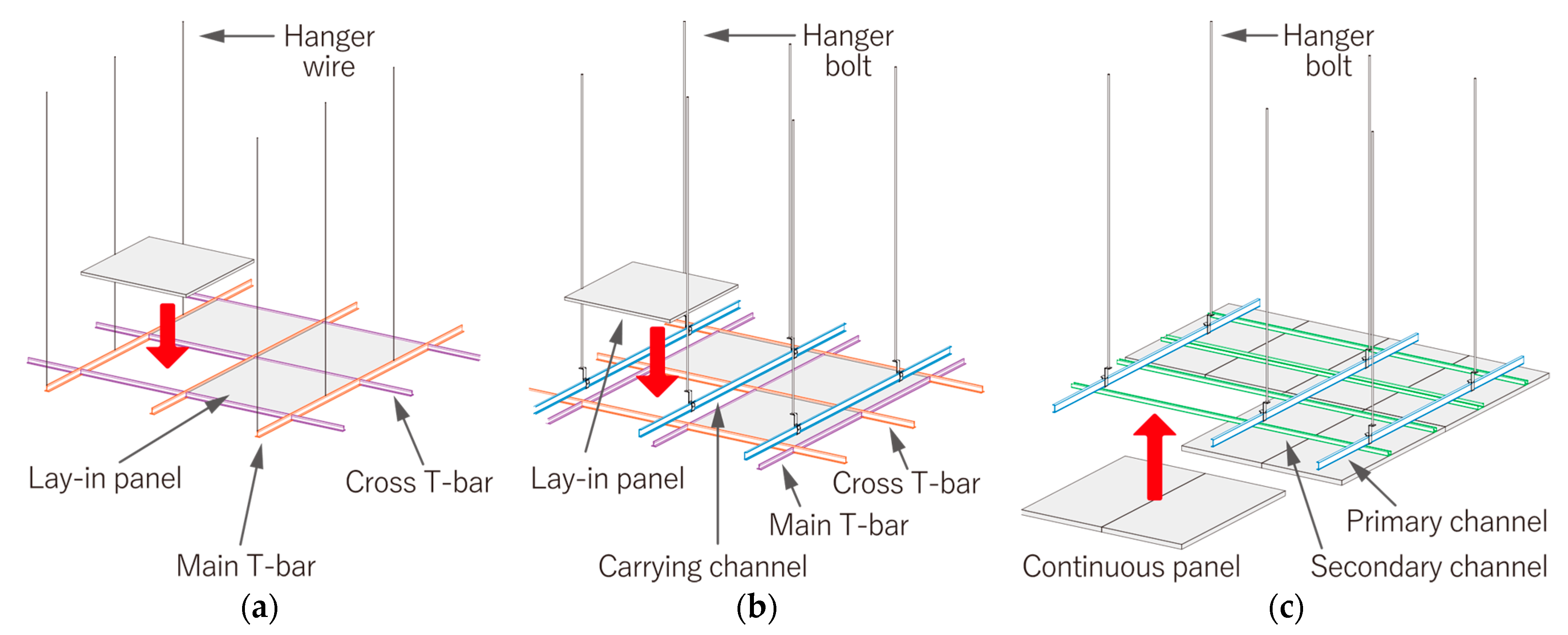
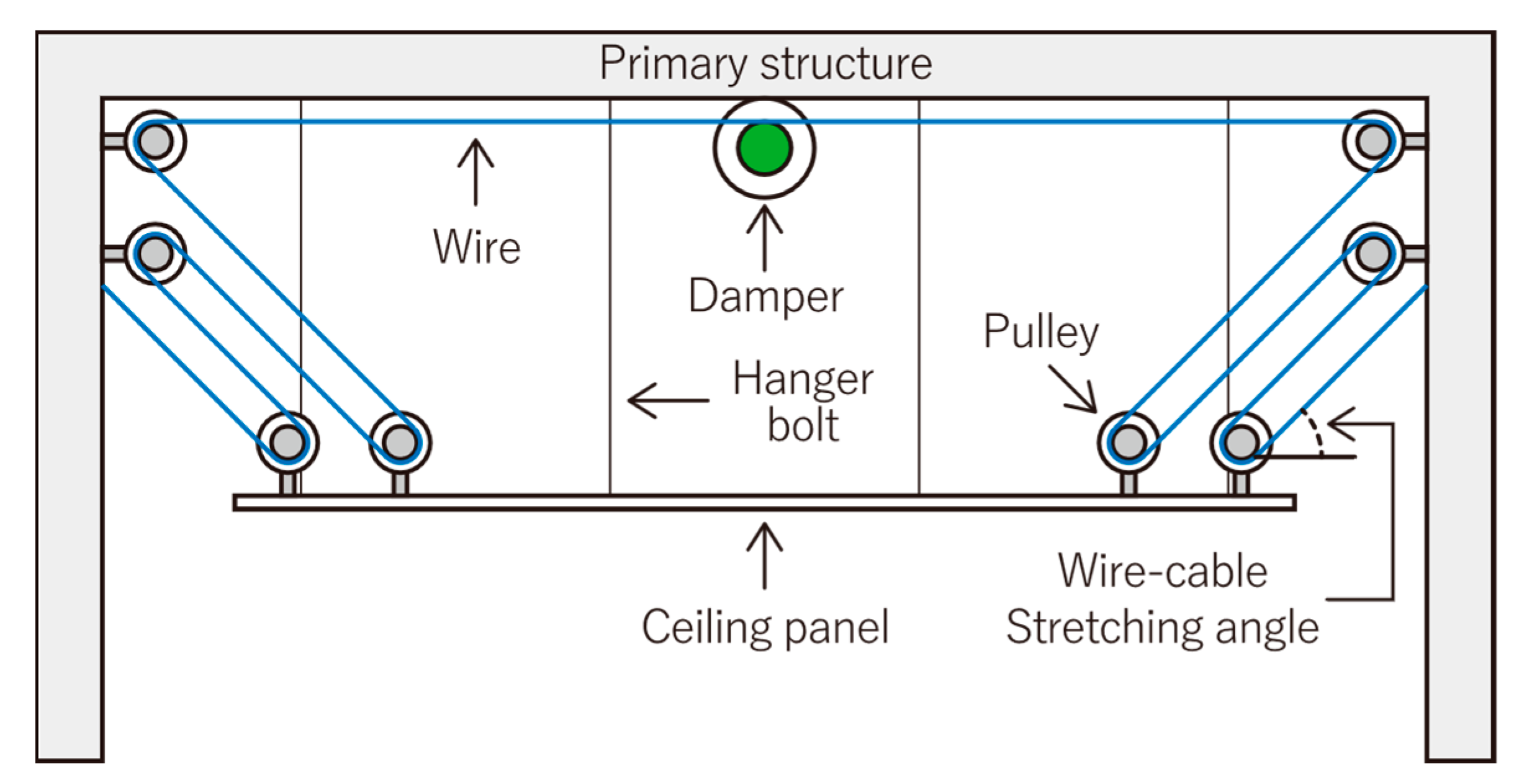

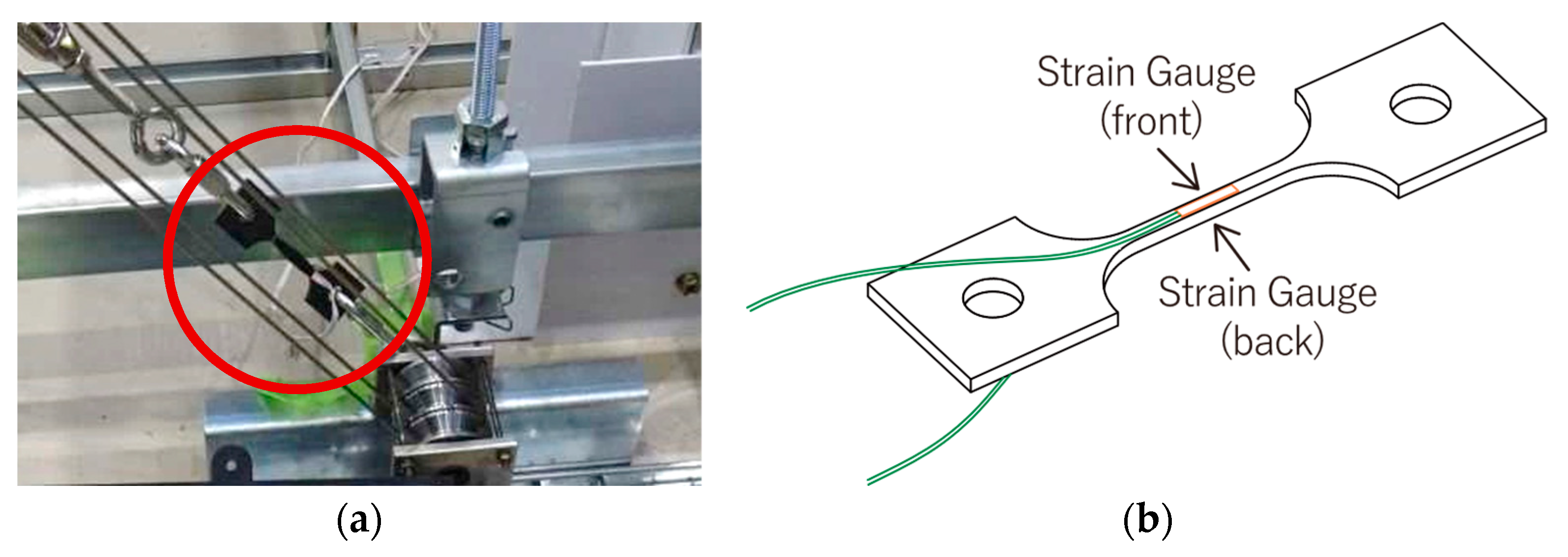
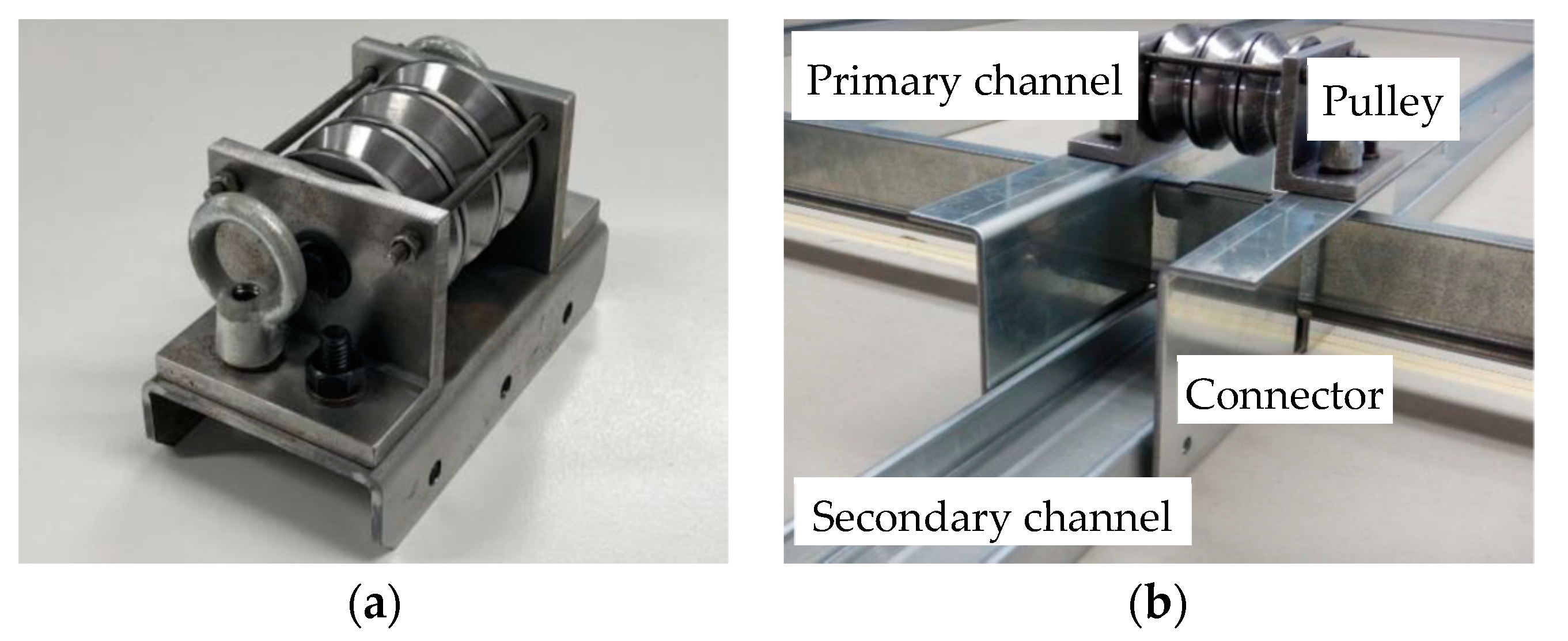
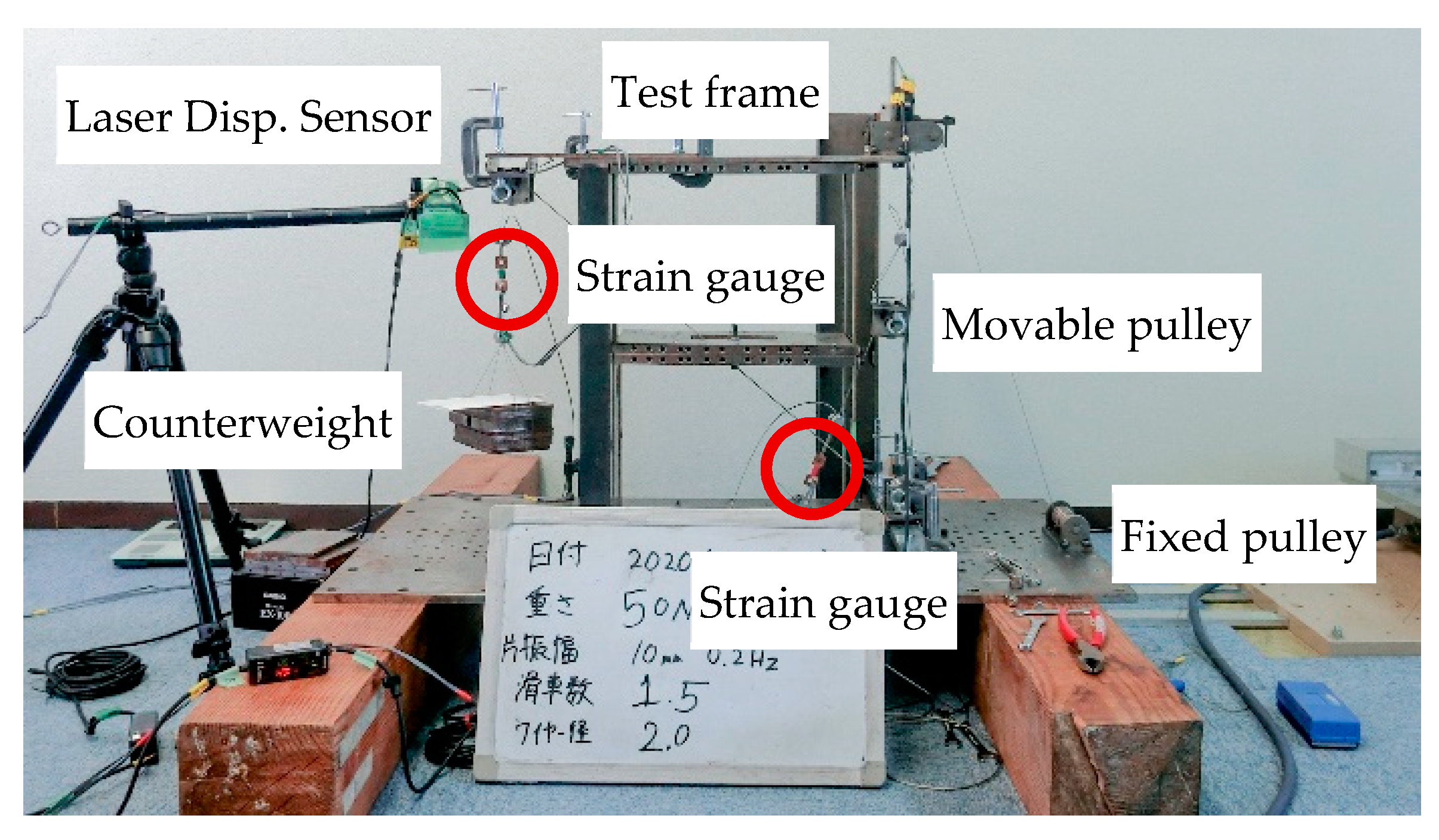
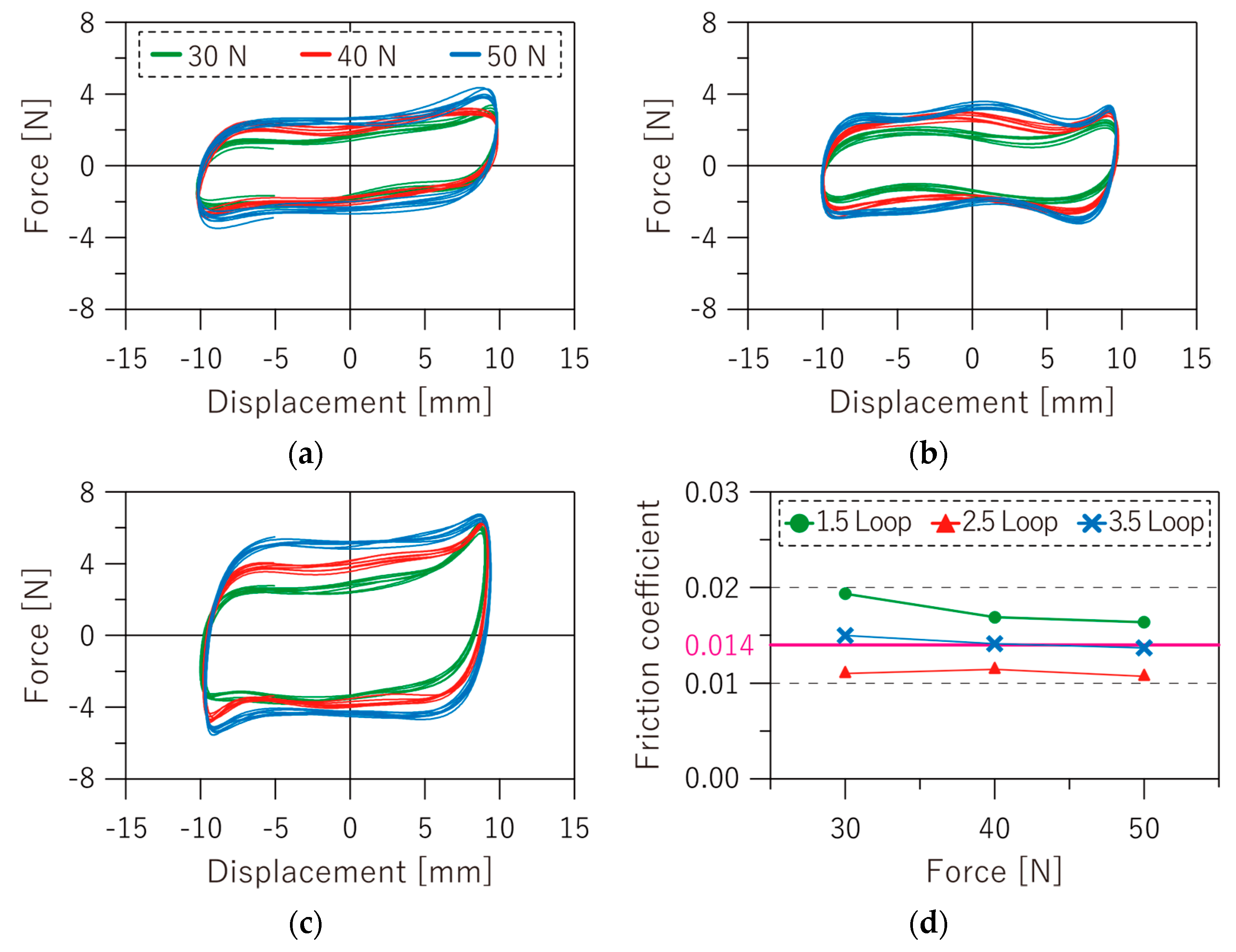
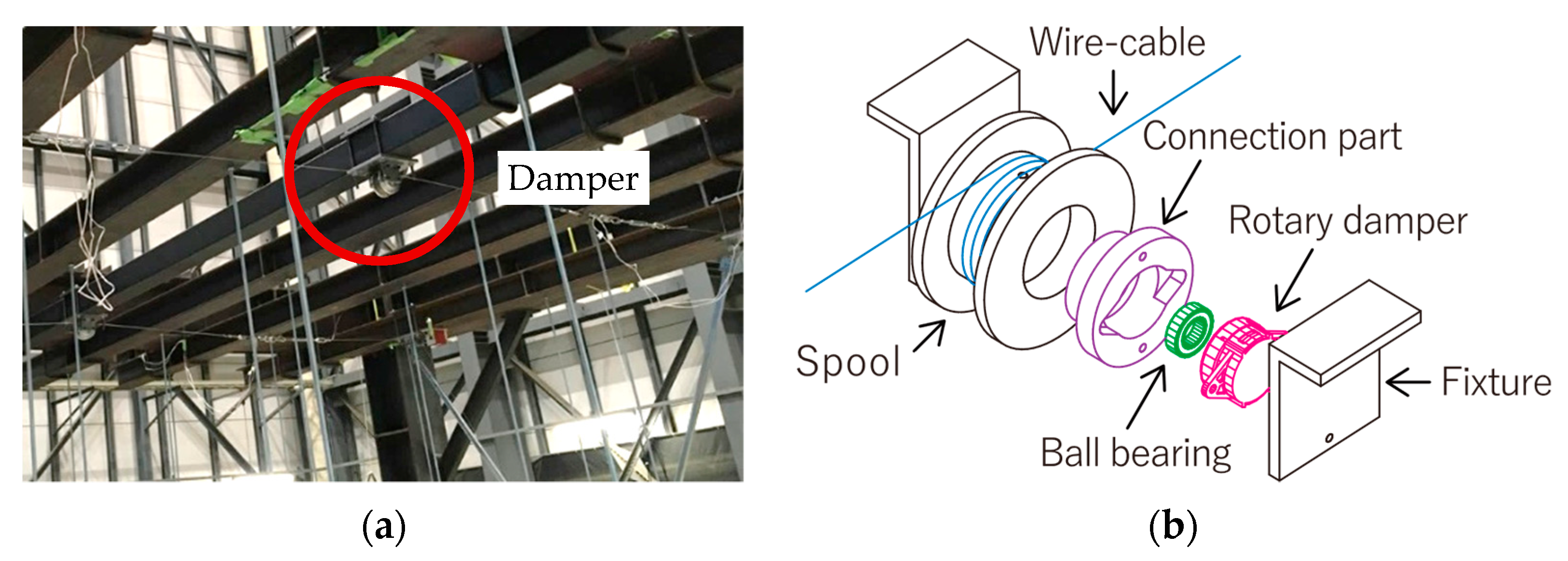
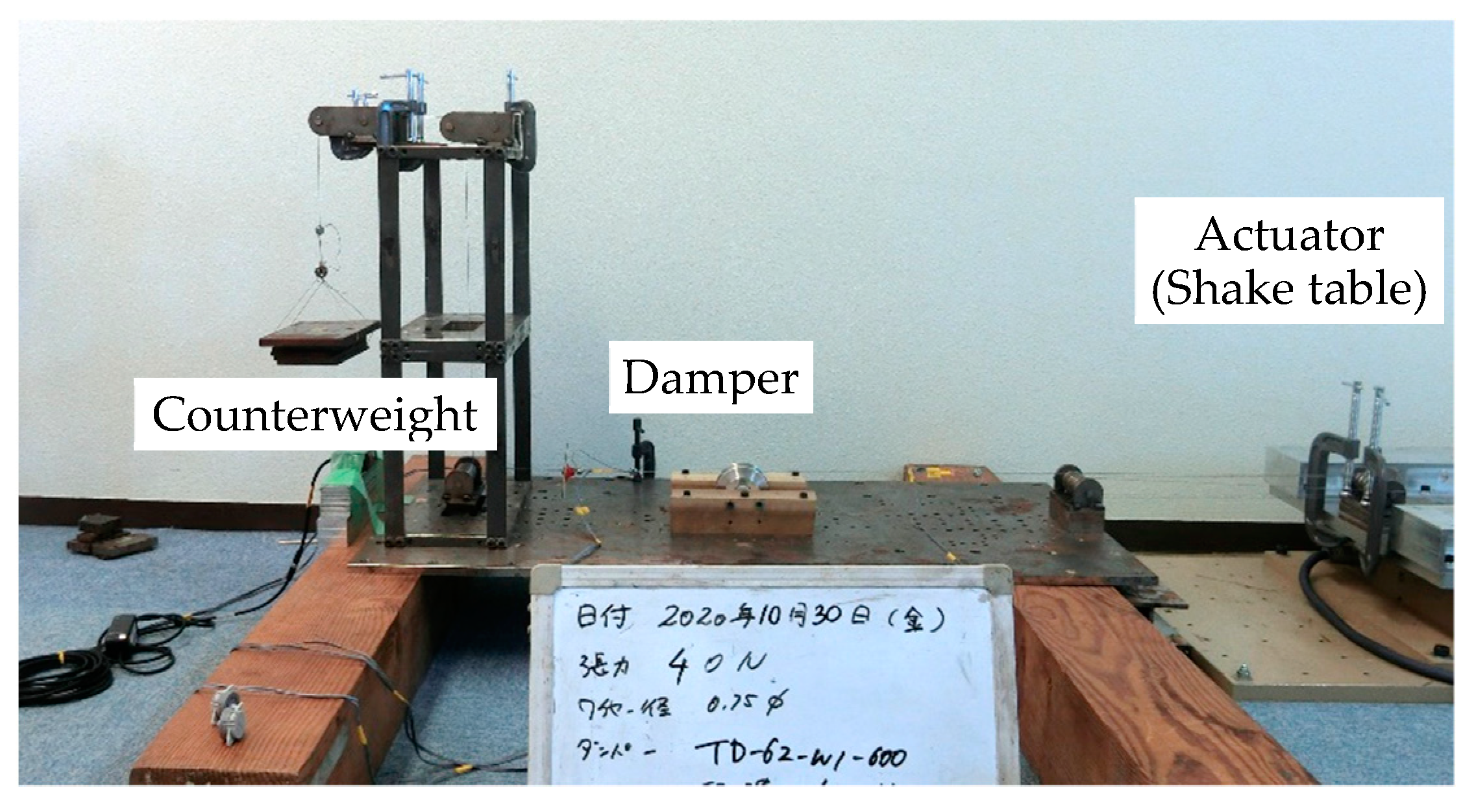
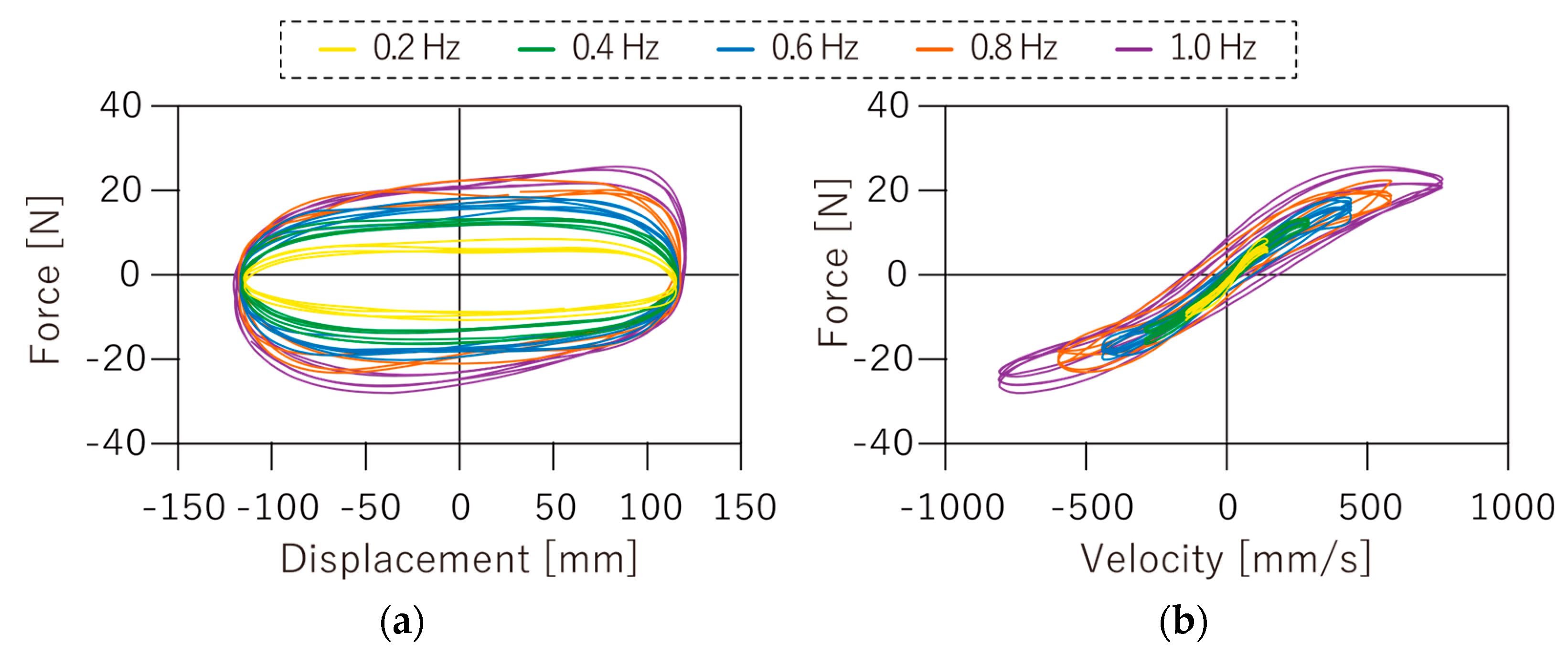
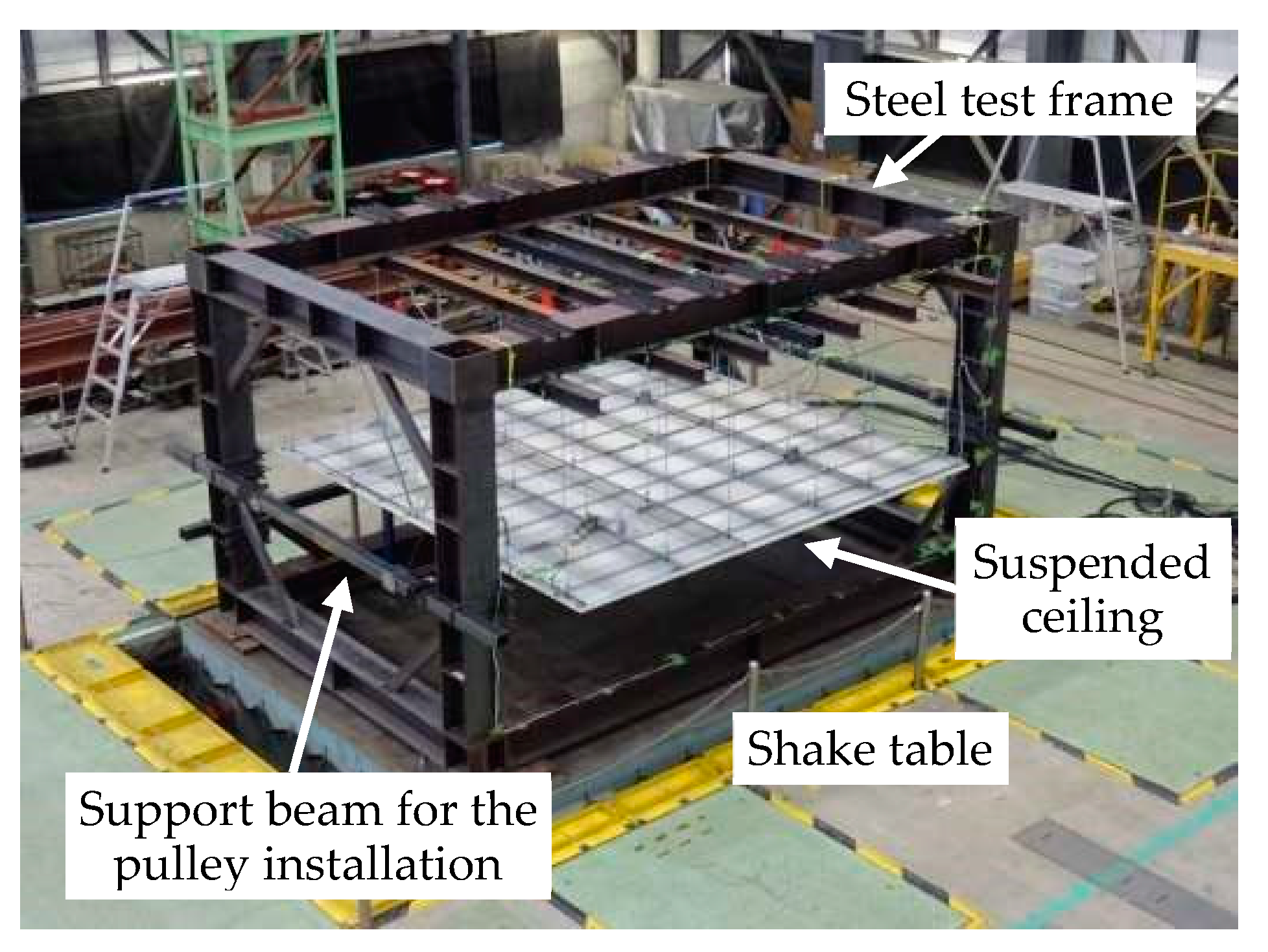
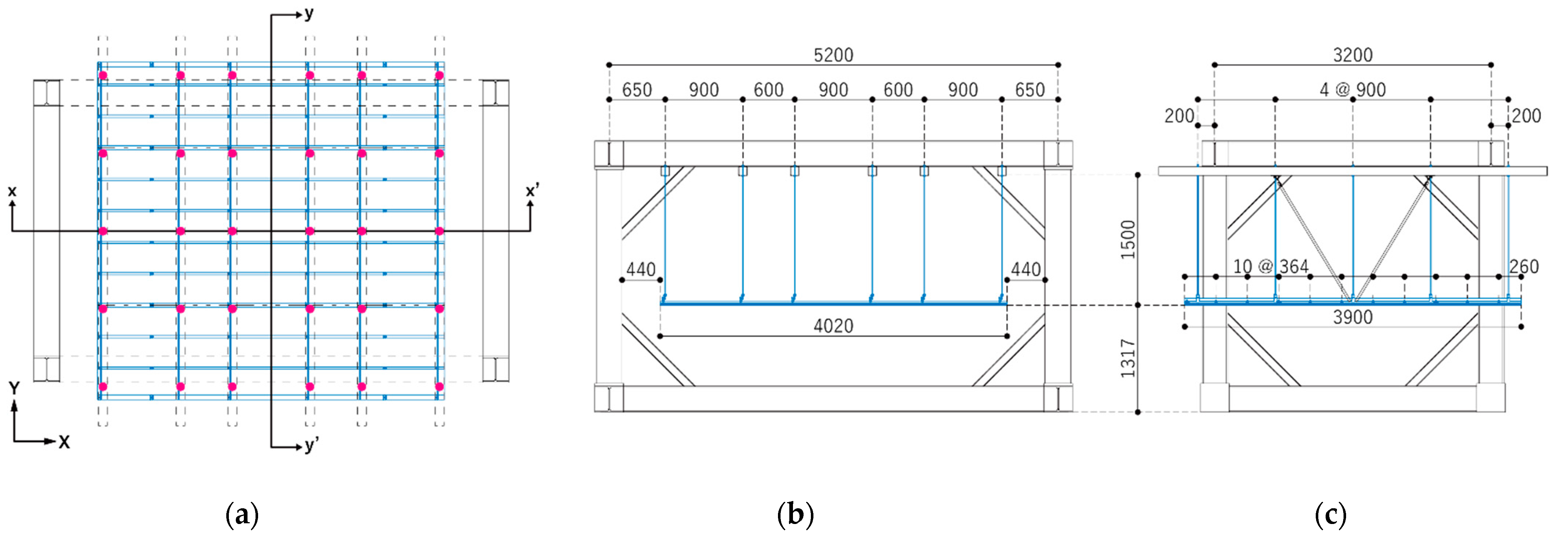
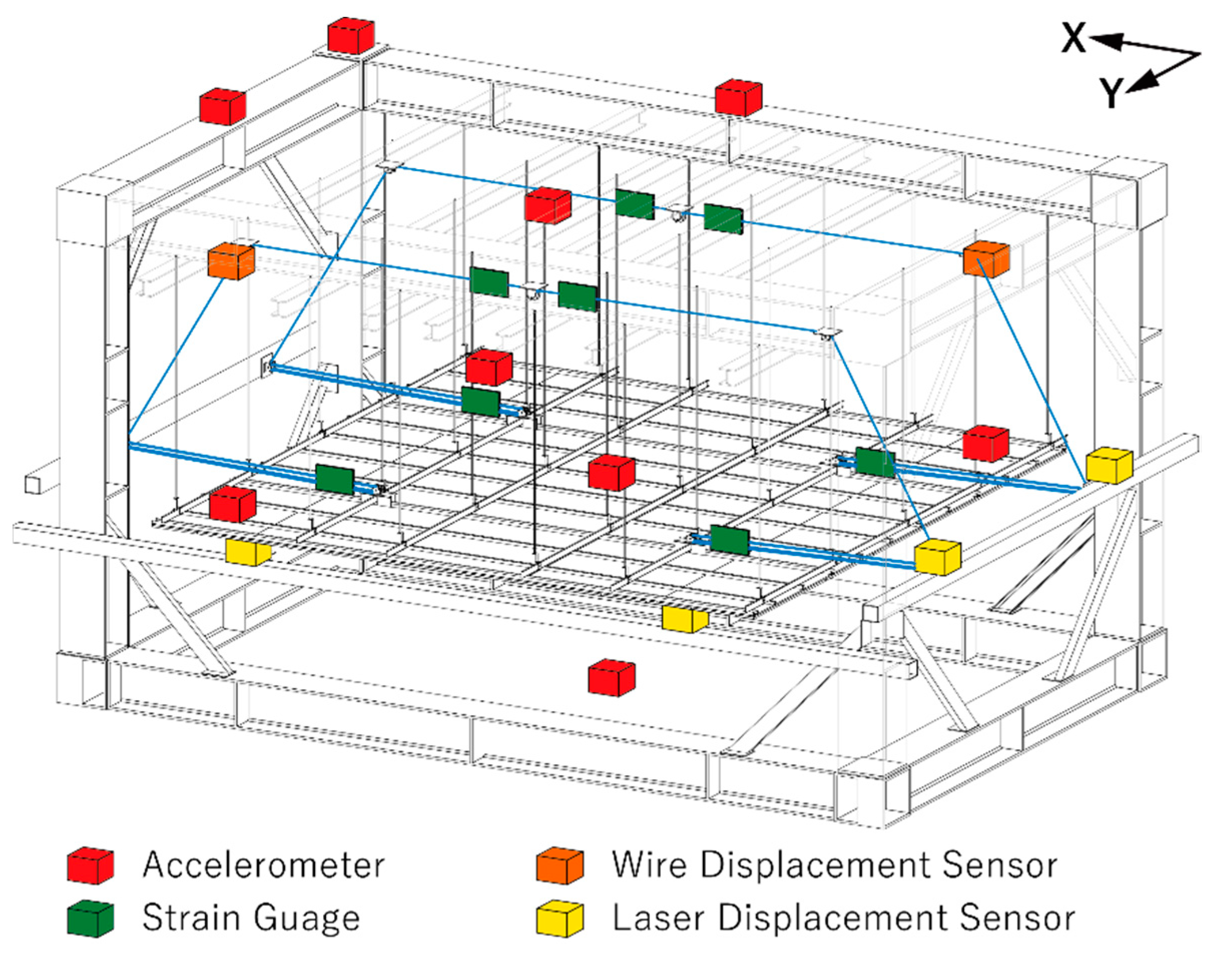


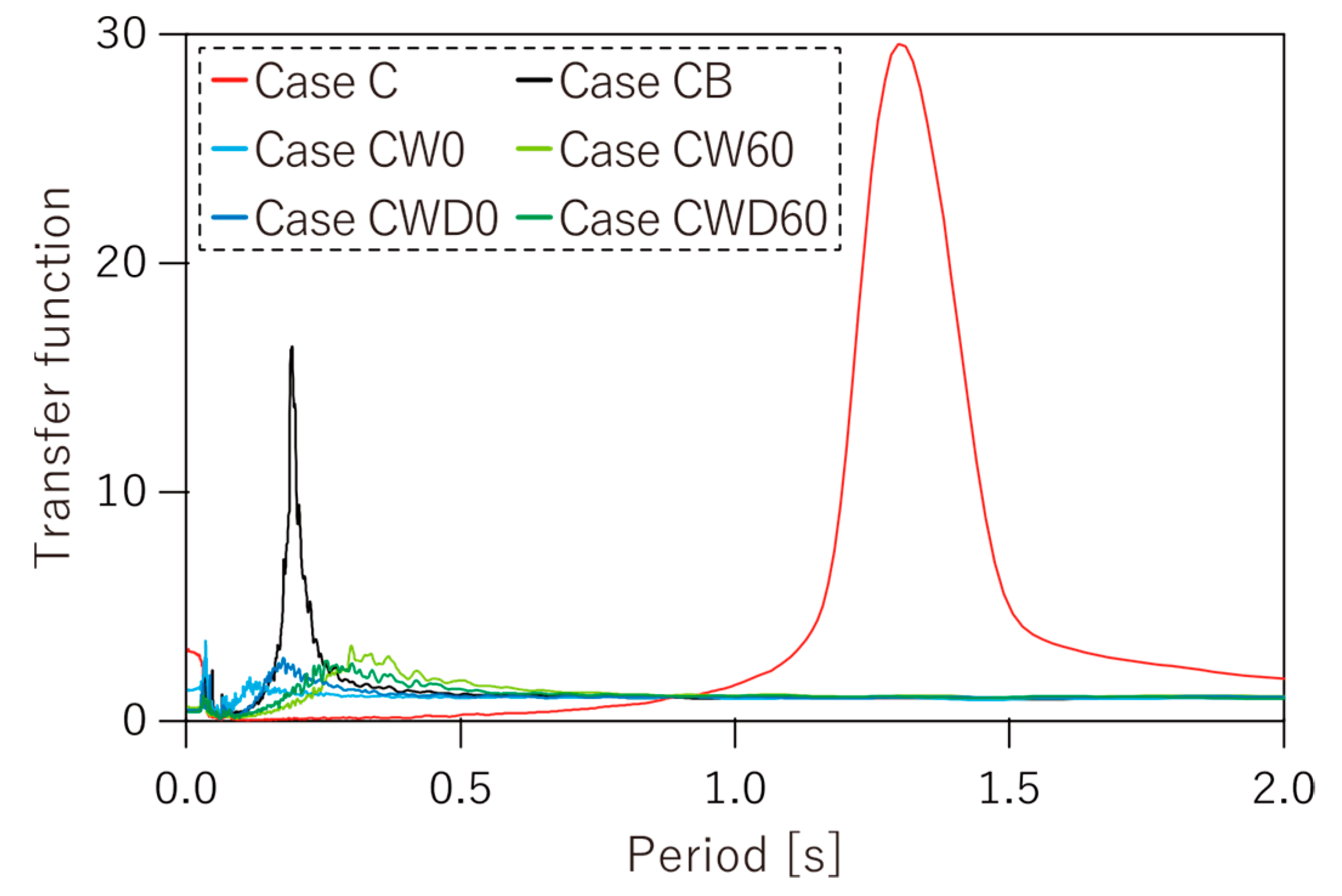
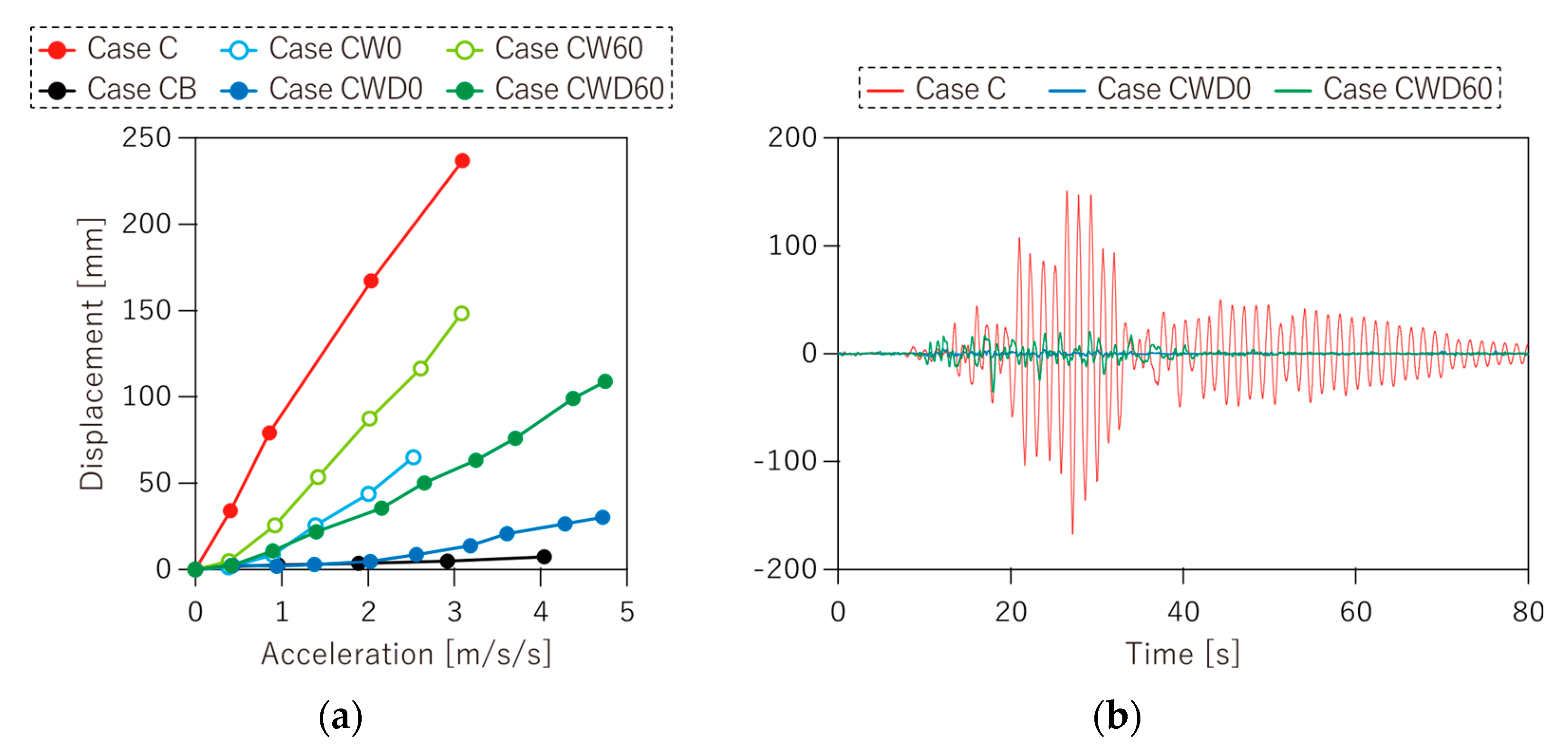
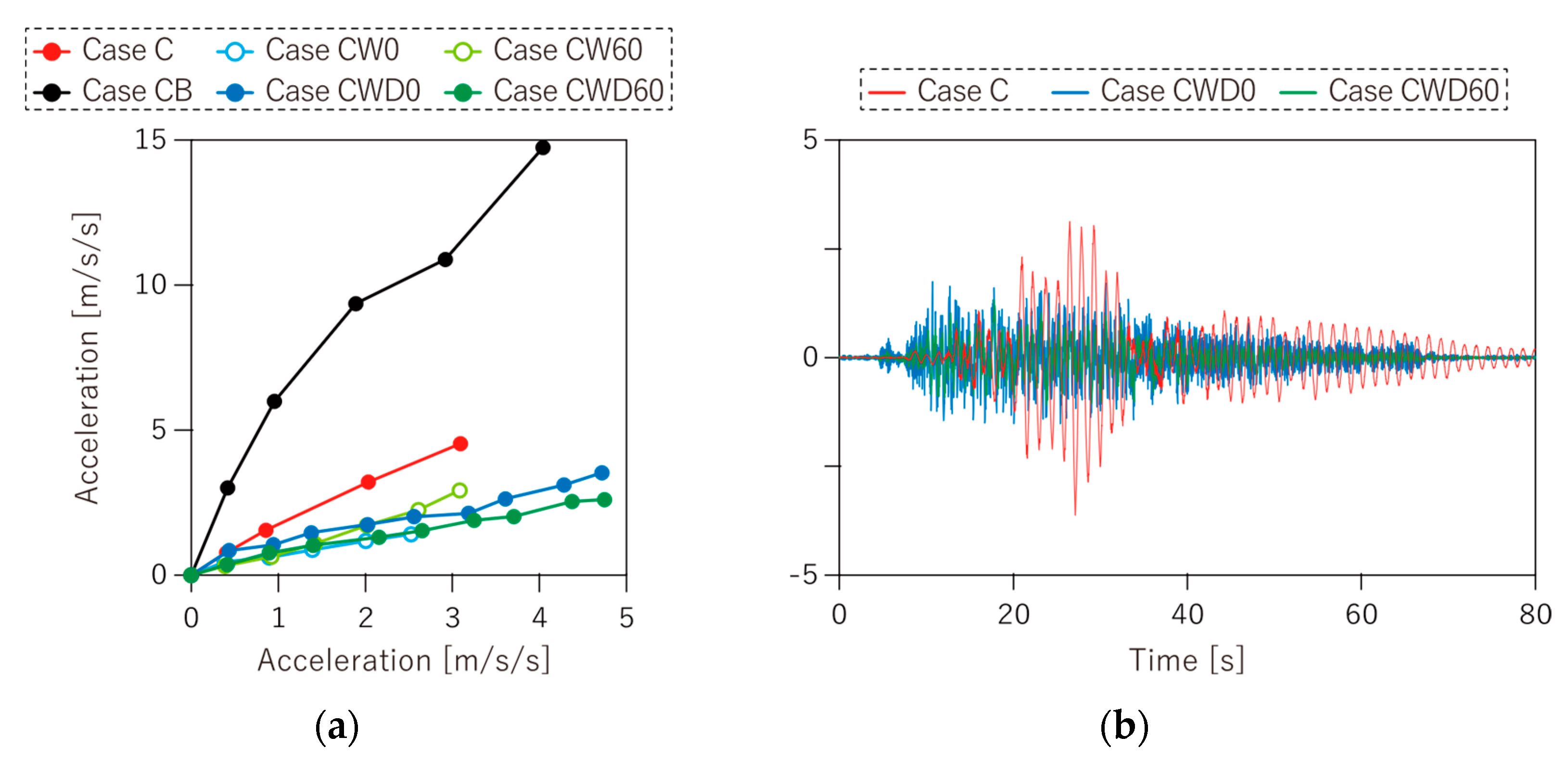
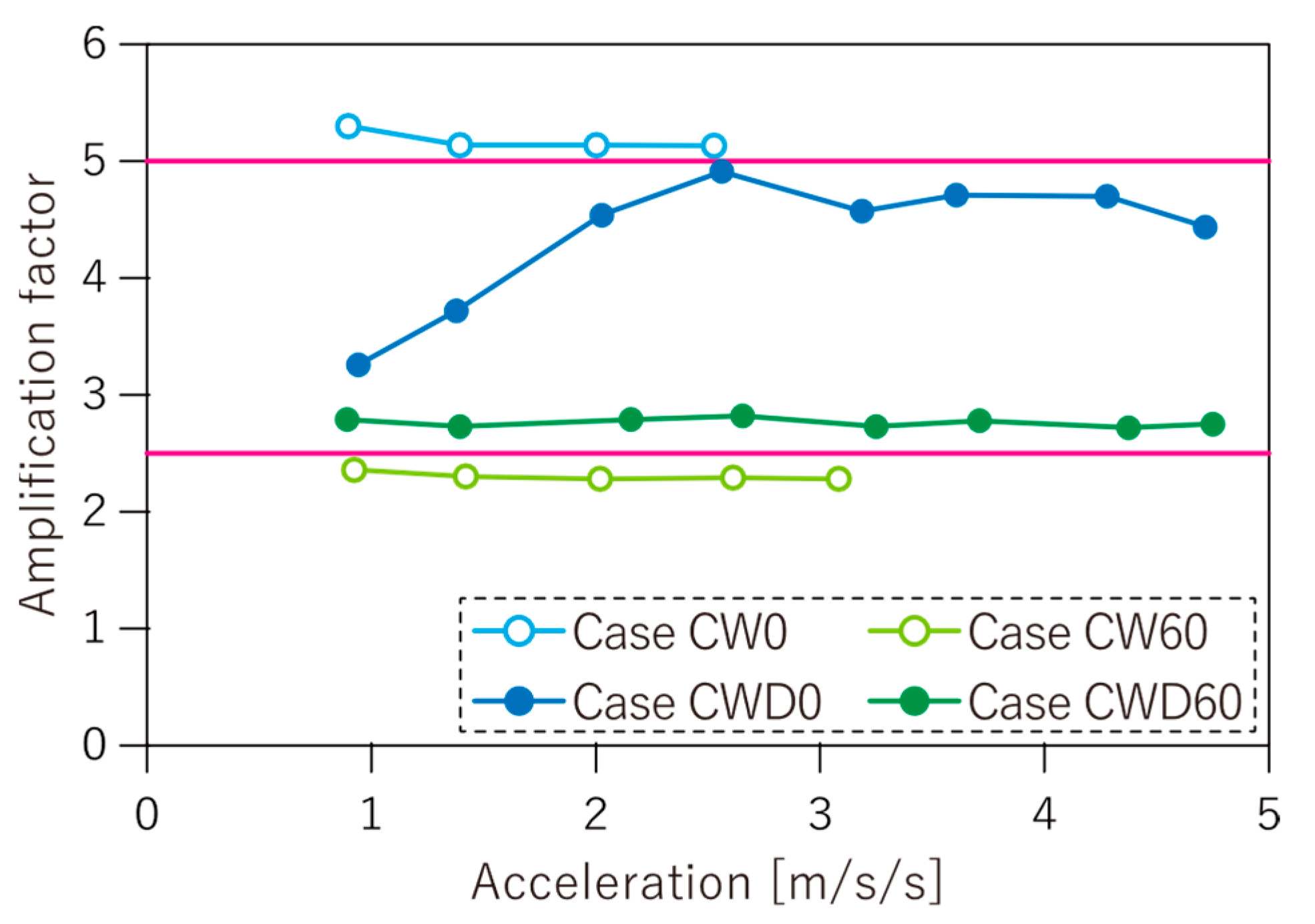
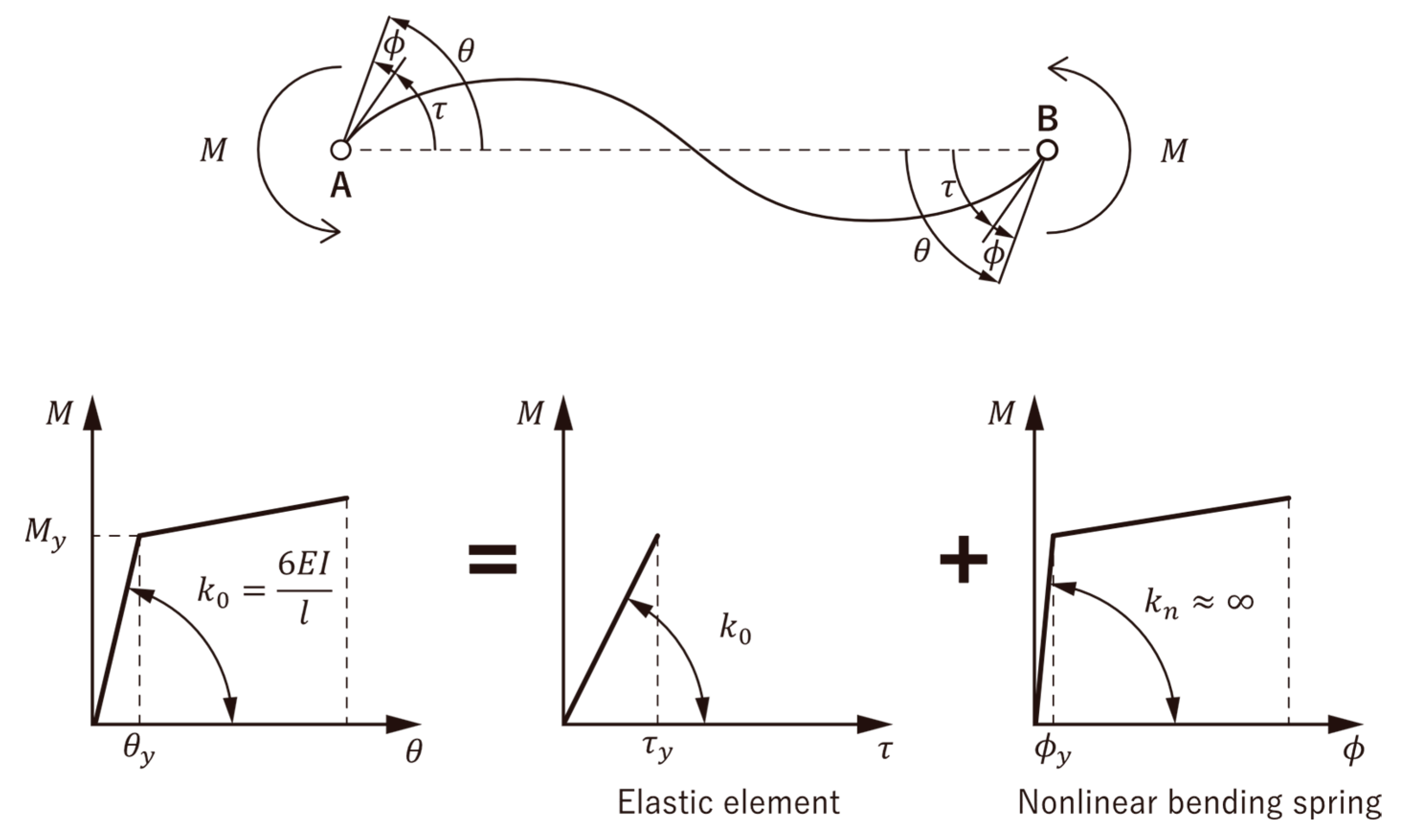
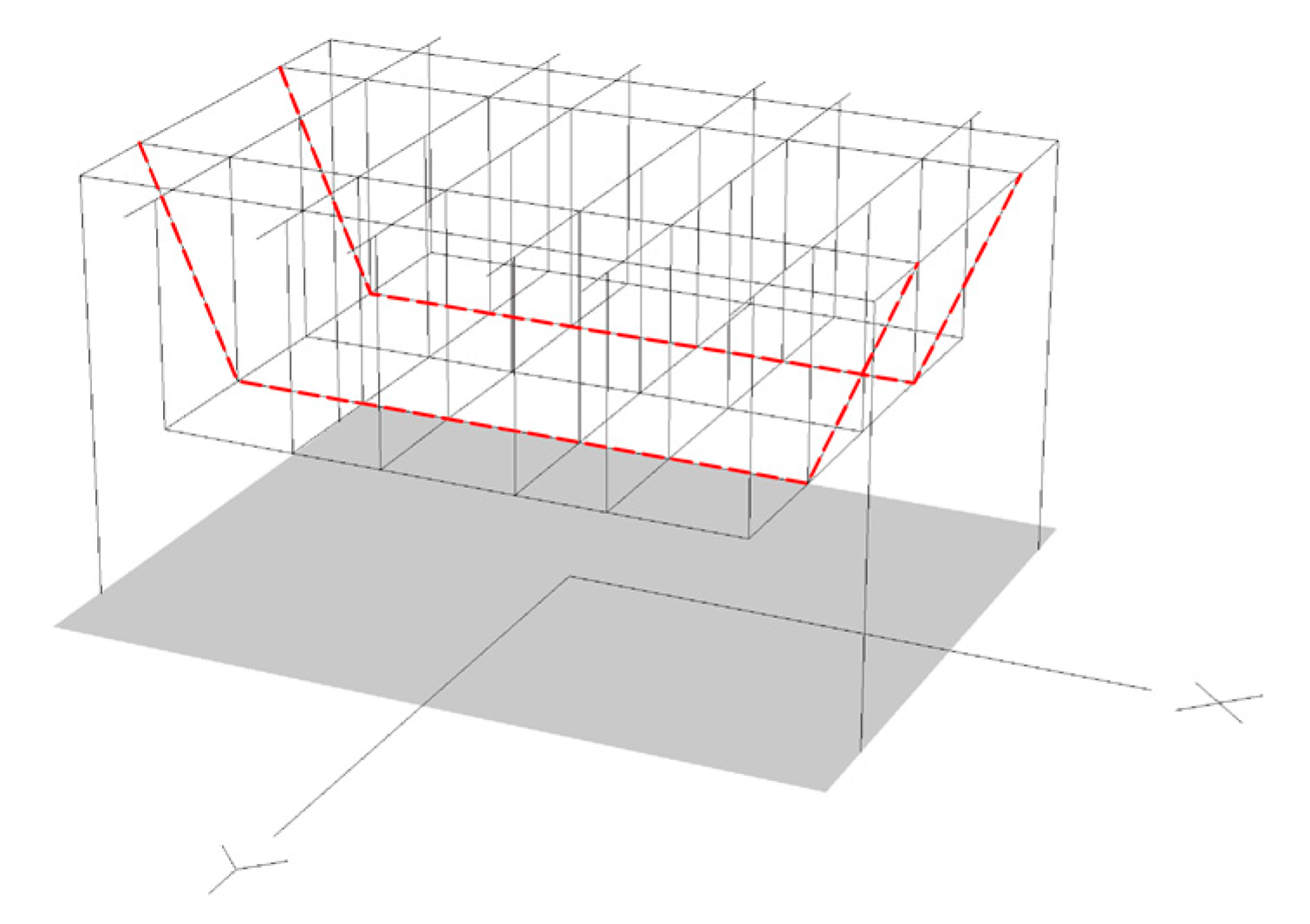
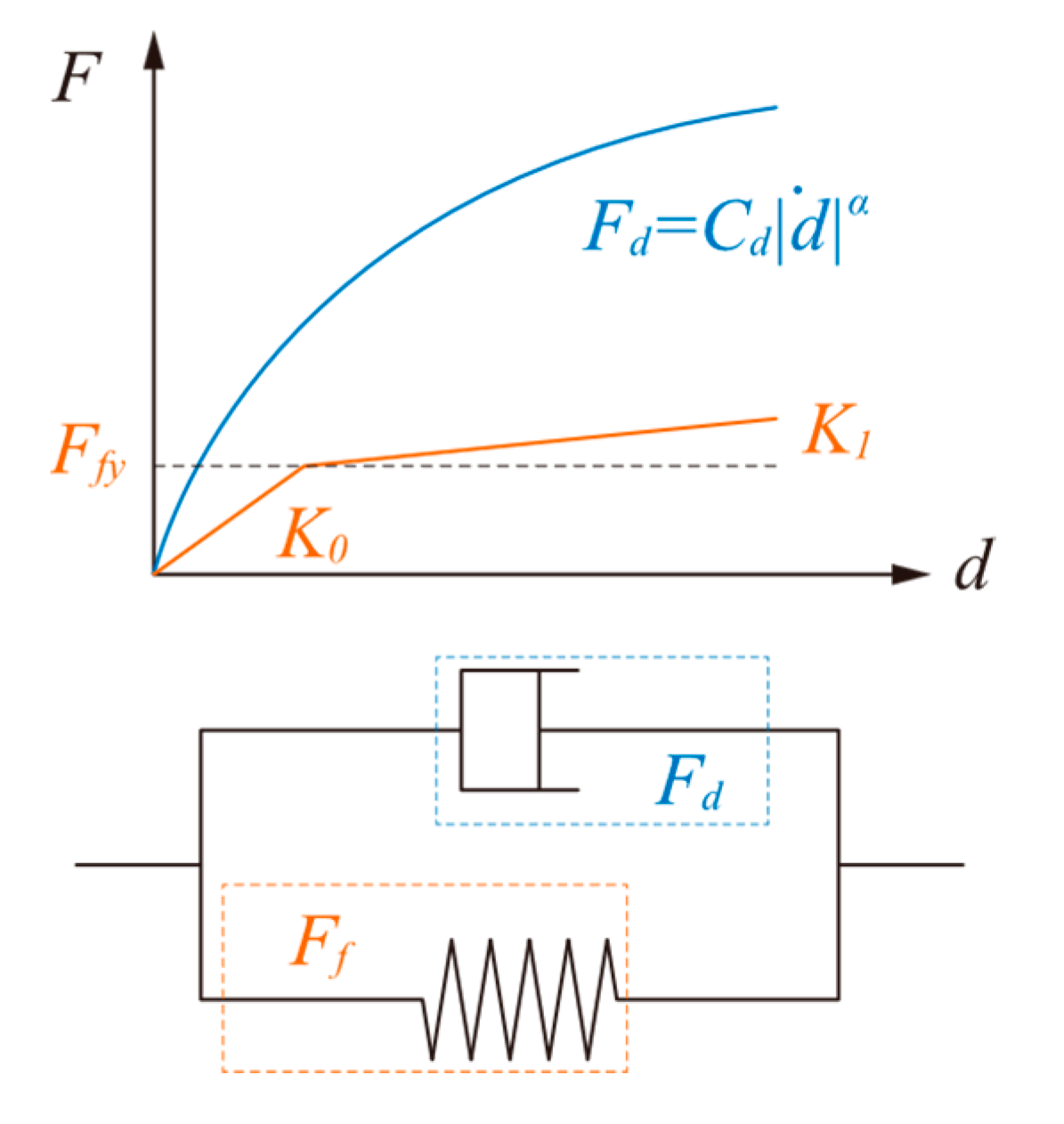

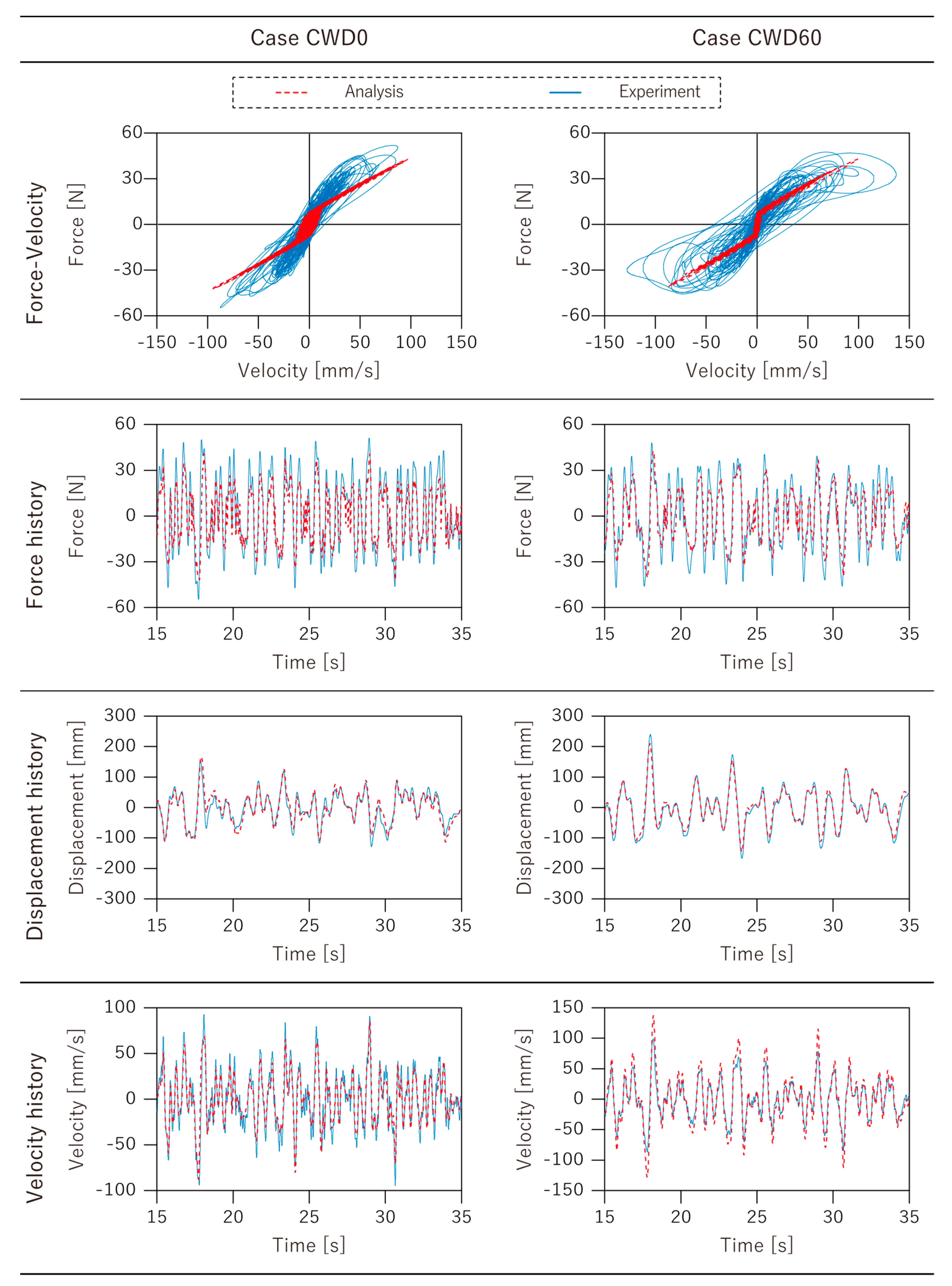
| Test Case | Number of Loops (Activated Sheaves) | Pre-Tension Force |
|---|---|---|
| No.1 | 2 (5) | 30 N |
| No.2 | 3 (7) | 40 N |
| No.3 | 4 (9) | 50 N |
| Conventional Type (SCS + Brace) | Wire Type (SCS + Wire) | Damper Type (SCS + Wire + Damper) |
|---|---|---|
 | 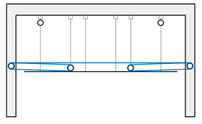 | 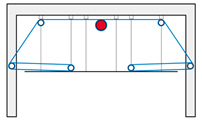 |
| Case C | Case CW0 | Case CWD0 |
 | 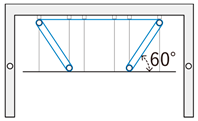 | 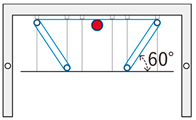 |
| Case CB | Case CW60 | Case CWD60 |
| PGA | Case CB | Case CW0 | Case CW60 | Case CWD0 | Case CWD60 |
|---|---|---|---|---|---|
| 1 m/s/s | 0.03 | 0.11 | 0.32 | 0.02 | 0.14 |
| 2 m/s/s | 0.02 | 0.26 | 0.52 | 0.03 | 0.21 |
| 3 m/s/s | 0.02 | ― | 0.63 | 0.06 | 0.27 |
| Average | 0.03 | 0.18 | 0.49 | 0.04 | 0.21 |
| PGA | Case C | Case CW0 | Case CW60 | Case CWD0 | Case CWD60 |
|---|---|---|---|---|---|
| 1 m/s/s | 0.29 | 0.1 | 0.11 | 0.17 | 0.13 |
| 2 m/s/s | 0.39 | 0.13 | 0.18 | 0.19 | 0.14 |
| 3 m/s/s | 0.46 | ― | 0.27 | 0.2 | 0.17 |
| Average | 0.38 | 0.11 | 0.19 | 0.19 | 0.15 |
| Damper Type | Parameter | |
|---|---|---|
| Bilinear model | Initial stiffness [N/mm] | 110 |
| Stiffness ratio | 0.0001 | |
| Yield force [N] | 6 | |
| Nonlinear viscous dashpot model | Damping coefficient [N∙(s/mm)α] * | 0.06 |
| Velocity exponent | 0.9 | |
| Case Name | Acceleration Response | Displacement Response |
|---|---|---|
| Case C | 0.86 | 0.93 |
| Case CW0 | 0.98 | 0.97 |
| Case CW60 | 0.69 | 0.79 |
| Case CWD0 | 0.70 | 0.99 |
| Case CWD60 | 0.94 | 0.82 |
| All cases | 0.83 | 0.91 |
Publisher’s Note: MDPI stays neutral with regard to jurisdictional claims in published maps and institutional affiliations. |
© 2022 by the authors. Licensee MDPI, Basel, Switzerland. This article is an open access article distributed under the terms and conditions of the Creative Commons Attribution (CC BY) license (https://creativecommons.org/licenses/by/4.0/).
Share and Cite
Majima, R.; Sakai, S.; Saito, T. Development of Vibration Control Structure on Suspended Ceiling Using Pulley Mechanism. Appl. Sci. 2022, 12, 3069. https://doi.org/10.3390/app12063069
Majima R, Sakai S, Saito T. Development of Vibration Control Structure on Suspended Ceiling Using Pulley Mechanism. Applied Sciences. 2022; 12(6):3069. https://doi.org/10.3390/app12063069
Chicago/Turabian StyleMajima, Ryo, Shigeki Sakai, and Taiki Saito. 2022. "Development of Vibration Control Structure on Suspended Ceiling Using Pulley Mechanism" Applied Sciences 12, no. 6: 3069. https://doi.org/10.3390/app12063069
APA StyleMajima, R., Sakai, S., & Saito, T. (2022). Development of Vibration Control Structure on Suspended Ceiling Using Pulley Mechanism. Applied Sciences, 12(6), 3069. https://doi.org/10.3390/app12063069






